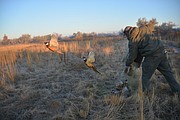Harvest a few birds today, get a few birds tomorrow
Jim Hagedorn remembers those days.
The days when pheasant hunters would descend onto a farm field and shoot a limit of ringnecks before noon, or before church on Sundays. Those days when he and friends went out and killed their limit of birds before the first football game was tuned in on the television are something he reminisces about a little, but not for long.
He is too busy trying to bring pheasant numbers back to north central Idaho.
Hagedorn, 87, of Viola, executive director of the Game Bird Foundation, was raised among smooth bores and whirring wings.
“I was bird dogging for my dad as soon as I could walk,” he said. “Everybody hunted birds. We had a lot of birds on the farm.”
When his family moved from Nebraska to south central Washington their hunting heritage tagged along.
And the hunting was good.
“We hunted the Columbia Basin when the bird hunting was really starting there,” Hagedorn said. “We would hunt the beet fields and limit out within seven rows of beets.”
That was in the 1960s and early 1970s, when hunters would be out for a few hours and come home with five roosters and two hens, he said.
And although he remembers the days when pheasants around the Palouse and Clearwater burgeoned, and populations remained strong for so long that Idaho Fish and Game opted to no longer raise and release birds into what appeared a robust, self-sustaining population, bird numbers these days can use help.
And they get it from Hagedorn’s group that has been releasing thousands of birds annually from Potlatch to Deary, to Greencreek, Lewiston and back.
The survival rates of eggs and hatchlings from wild nesting birds in many parts of Idaho isn’t real good, he said, in part because ravens destroy a large percentage of nests and eat what’s in them, Hagedorn said. Coyotes and racoons are also on the list of predators.
His group raises birds in several soft release pens across a 500-square mile area of north central Idaho. The pens allow birds to come back to feed or for shelter, but once they are mature, birds in the pens venture out on their own.
“This year in the Clearwater we raised and turned loose 8,500 pheasant chicks,” he said. “By the time they are eight to 10 weeks old, they are pretty well acclimated to the outdoors.”
The annual survival rate of the birds is about 30 percent, he said, depending on how stern the winter. Cold, wet winters take their tolls on birds.
Hagedorn has worked with landowners throughout a five-county area including Latah, Nez Perce, Clearwater, Lewis and Idaho counties and envisions large swaths of bird-laden land, with access for hunters.
North Dakota raises and releases a quarter million birds annually, Hagedorn said, and in Pennsylvania almost a half-million birds are raised and released, while Idaho releases a fraction of those numbers.
“It’s a big thing,” he said. “If we can turn loose 100,000 birds instead of 10,000 birds, populations would come back pretty quick.”
After rearing pheasants for decades in an effort to provide hunters with wingshooting action, Hagedorn has learned that, compared to another popular hunt, deer hunting, pheasant hunting keeps giving back, he said.
Deer hunters spend weeks trying to get one shot, and then the hunt is over, he said.
“Pheasant hunting, if there are birds to hunt, is so much more popular than deer hunting,” he said. “But we don’t have the birds, anymore to hunt. So, that’s what we’re trying to bring back.”
The association seeks to secure land that provides pheasants with good habitat, and loading it with birds for hunters.
“So you can go out with your kids and maybe get a couple birds today, and then go out tomorrow and get a couple birds tomorrow, and keep going like that.” he said. “That’s what we’re striving to do.”



